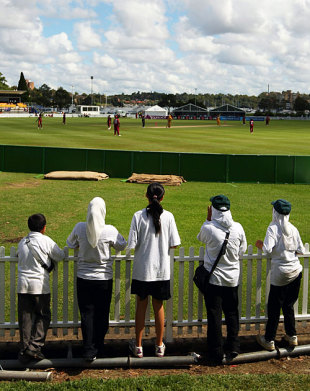A St Patrick's Day out at cricket
Jenny Roesler
25-Feb-2013

| ||
By Jenny Roesler
“Happy St Patrick’s Day,” said a South African man while I was waiting for the bus. He saw my clover green top – must have been a subconscious thing – and noted that I was on my way to Drummoyne, where a large contingent will gather in the appropriately Irish-sounding PJ Gallagher’s pub for the celebrations.
If I was heading to the pub, it was a little bit early for Guinness at 8am. And my destination involved England and West Indies teams though Ireland could have been here had they taken fifth place at the last World Cup instead of West Indies. As it was, they were surprisingly way off the pace, without a single win in the tournament, and missed out on a spot this time through losing to Pakistan in the qualifiers.
Lying several kilometres west of Sydney’s Central Business District, Drummoyne - meaning flat-topped ridge - was settled not by an Irishman, however, but a Scotsman, the merchant whaler and sealer William Wright. With a largely industrial background, Drummoyne has some stunning Georgian buildings – and an even better location for the picturesque oval, constructed in 1931 as a Depression project. Sadness is the last thing on anyone’s minds today under the gentle sun and a relaxed, though competitive, vibe. One man even backed England to pound 300 against West Indies. He may bask in the sun but not quite the glory – a flurry of wickets made sure the bookies were kept happy.
The oval is surrounded by grassy banks which slope gently down to the Parramatta River where a motley fleet of white yachts stand proudly ready for service. Some larger venues may be surrendering their grass verges for bucket seats but there is no such danger here, with slopes running right round the ground, broken only by the pavilion and the temporary media cabin to its left. It is the Balmain club’s home ground and also houses Drummoyne Rugby Club and some AFL matches.
On the short trip to the ground, I caught my first glimpse of the Harbour Bridge and paused to reflect on its magnificent, yet foreboding, history.
A bridge was first proposed back in 1815 but it was another 85 years until a competition was launched. All entries were rejected but the next year a formal proposal was finally accepted. The formidable bridge would weigh 52,800 tonnes, with six lanes of traffic, two railway tracks and two footpaths. The parts were made from 1923 in sheds where Luna Park is now situated, and it was only six years later that building began on the actual site.
Like Drummoyne Oval, its construction helped create jobs in the Depression and for that reason it was known as the Iron Lung. But it came at a price - $10million, the destruction of 800 houses and 16 workers’ lives.
More quirkily, along the 2.4-kilometre-long Bradfield Highway which runs across the bridge and is named after its designer John Bradfield, between midnight and dawn it is permissible to herd livestock after giving notice. The right has not been invoked for half a century and, like Andrew Flintoff’s Freedom of Preston which permits him to drive sheep through the city, is likely to stay that way under the weight of today’s traffic and the expected lack of need. Flintoff, however, may still be tempted to make good use of his right to a free pint in every pub whenever he visits his home town from his Cheshire pad.
The bridge was finally opened in 1932, more than a century after the original idea – but the ceremony was to be remembered for the wrong reasons. The state’s premier, Jack Lang, was asked to cut the ribbon but his thunder was stolen by a horse-rider who trotted up and did the honours himself, declaring the bridge open in the name of the people of New South Wales. The stranger was unmasked as Francis de Groot, a member of a right-wing parliamentary group who believed the Governor General, Sir Isaac Isaacs should have taken the honour. All manner of attempts to nail de Groot legally fell apart, but he was fined £5 for trespassing, while the ribbon had been quickly restored.
Jenny Roesler is a former assistant editor at Cricinfo